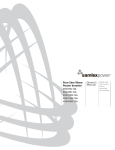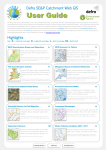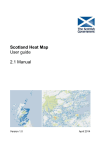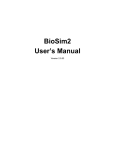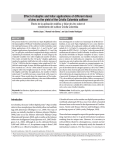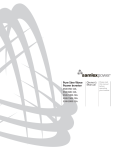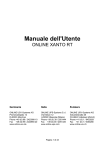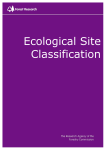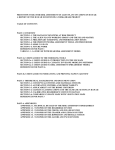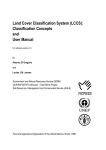Download Regulatory Method (WAT-RM-37)
Transcript
Water Use Regulatory Method (WAT-RM-37) Regulation of Phosphorus Discharges to Freshwater Lochs Version: v2 Released: Jul 2014 Copyright and Legal Information Copyright© 2014 Scottish Environment Protection Agency (SEPA). All rights reserved. No part of this document may be reproduced in any form or by any means, electronic or mechanical, including (but not limited to) photocopying, recording or using any information storage and retrieval systems, without the express permission in writing of SEPA. Disclaimer Whilst every effort has been made to ensure the accuracy of this document, SEPA cannot accept and hereby expressly excludes all or any liability and gives no warranty, covenant or undertaking (whether express or implied) in respect of the fitness for purpose of, or any error, omission or discrepancy in, this document and reliance on contents hereof is entirely at the user’s own risk. Registered Trademarks All registered trademarks used in this document are used for reference purpose only. Other brand and product names maybe registered trademarks or trademarks of their respective holders. Update Summary Version v1.0 Description First issue for Water Use reference using approved content from the following documents: RM 37 Regulation of discharges to freshwater lochs dec2010.doc NOTE: WAT-RM-37 replaces WAT-SG-10 v1.1 Re-issued with cover note about PLUS+ model availability. v1.2 Figure 1, first box revised to read ‘Derive site specific standard’ v2 Revised to reflect the Standards Directions 2014 Notes References: Linked references to other documents have been disabled in this web version of the document. See the References section for details of all referenced documents. Printing the Document: This document is uncontrolled if printed and is only intended to be viewed online. If you do need to print the document, the best results are achieved using Booklet printing or else double-sided, Duplex (2-on-1) A4 printing (both four pages per A4 sheet). Always refer to the online document for accurate and up-to-date information. 2 of 18 Uncontrolled if printed v2 Jul 2014 Table of Contents 1. Purpose , Scope and Background.......................................................................4 1.1 Purpose and Scope ..................................................................................4 1.2 Background...............................................................................................4 2. Classification and Environmental Standards .......................................................6 2.1 Environmental Standards..........................................................................6 2.2 Classification.............................................................................................6 3. Assessing the Impact of an Activity .....................................................................6 3.1 Allocation of capacity ................................................................................6 3.2 The PLUS+ Model.....................................................................................6 3.3 Impact Assessment...................................................................................6 3.4 Determining the Application ......................................................................6 Annex A. Derivation of loch total phosphorus site specific standards ....................6 A.1. Introduction ...............................................................................................6 A.2. Governance ..............................................................................................6 A.3. Classification approach .............................................................................6 A.4. Calculation of site-specific standards........................................................6 A.5. Application of revised standards ...............................................................6 A.6. Site-specific standards spreadsheet .........................................................6 References ..............................................................................................................6 v2 Jul 2014 Uncontrolled if printed 3 of 18 1. Purpose , Scope and Background 1.1 Purpose and Scope This guidance describes the process of how discharges of phosphorus into all types of freshwater loch should be considered. It can be used to assess: Applications for licences considered under The Water Environment Controlled Activities (Scotland) Regulations 2005 e.g. fish farms and sewage discharges. Indicative Forestry Strategies. Forest Design Plans and large scale Forestry planting and felling consultations. For further details please see “Guidance on the Water Framework Directive including river basin planning” on SEPA’s Planning website. The principles can also be used for other river basin management planning purposes e.g. to help inform source apportionment studies. It covers all discharges of phosphorus into lochs including direct discharges (for example from cage fish farms, large sewage treatment facilities, small sewage discharges from a few houses) and from diffuse sources (such as forestry or agriculture). 1.2 Background Nutrient enrichment with phosphorus is recognised as a major threat to water quality and the status of Scottish freshwater lochs. Tourist developments, fish farming, and land use change have resulted in nutrient inputs to many standing water bodies. Where nutrient inputs are significant they can give rise to eutrophication significantly increasing the growth of phytoplankton in the loch. This can result in the growth of phytoplankton populations to nuisance proportions giving rise in extreme cases to “algal blooms”. Between 45% and 90% of blooms of blue-green algae are thought to produce toxins. These toxins are largely retained within the blue-green algal cells during their development and growth phases and are released, in the main, on cell death. These algal blooms can damage the value of the resource for industry, potable water supplies, nature conservation, fisheries and recreation and indicate a significant change in the loch ecology. High profile cases, such as Loch Leven, illustrate the difficulties of reversing the process of eutrophication once damage has occurred. The table below details the mechanism by which phosphorus is derived from these activities and the loading that each contributes. 4 of 18 Uncontrolled if printed v2 Jul 2014 Purpose , Scope and Background Table 1 Loadings and Mechanisms for Phosphorus Release from Various Activities Activity and primary control mechanism Mechanism for P release Loading Sewage discharges via CAR authorisation (see WAT-RM-03: Regulation of Sewage Discharges to Surface Waters) Phosphorus is present in the effluent This data is currently being updated. Please contact a PLUS+ user for further information Fish farming via CAR authorisation Fish feed and faeces from the fish A loading of 10kg P per tonne of Atlantic salmon smolt should be used unless the applicant can sufficiently justify the use of a different figure. Note: The figure can be substantially higher or lower for rainbow trout cages. Forestry via planning (see Guidance on the Water Framework Directive including river basin planning) and CAR GBR Application of phosphate fertilisers or nutrient releases following largescale felling operations, especially via sediment run-off. Data on loading from different land uses is available in the PLUS+ model and is dependant on slope. Farming via CAR GBR. Surface run-off following the application of manures and slurries or sediment run-off from farmland. Data on loading from different land uses is available in the PLUS+ model and is dependant on slope. v2 Jul 2014 Uncontrolled if printed 5 of 18 2. Classification and Environmental Standards 2.1 Environmental Standards The Standards Directions 2014 are set out in: The Scotland River Basin District (Surface Water Typology, Environmental Standards, Condition Limits and Groundwater Threshold Values) Directions 2014 The Solway Tweed River Basin District (Surface Water Typology, Environmental Standards, Condition Limits and Groundwater Threshold Values) (Scotland) Directions 2014 These Directions require SEPA to apply an environmental standard to lochs when exercising its functions under the Water Environment (Controlled Activities) (Scotland) Regulations 2011. It also specifies that these standards should be used to classify water bodies in line with the Water Environment and Water Services (Scotland) Act 2003. The standards set out in the 2009 direction are based on work carried out by the UKTAG – Water Framework Directive. Lochs in a natural condition contain and receive different amounts of phosphorus from their catchments. The natural state of their fertility varies and the impact of additional phosphorus depends on the sensitivity of the loch. Physicochemical factors affecting the sensitivity of a loch to phosphorus inputs include the alkalinity of the water and the depth (an indicator of the extent to which a lake is able to retain its phosphorus naturally). As a result, each loch ideally requires its own standard. The Directions allow loch water bodies to be classified using a site specific standard for each loch water body. Where suitable data for a specific loch are not available, the Directions set out type specific standards for each type of loch water body. These are typical standards for phosphorus depending on a variety of loch characteristics such as those set out above. These are not currently available on the GIS intranet site but can be obtained from SEPA’s Environmental Quality (EQ) team for all Scottish lochs of >1ha in surface area. Further information on the classification and standards for lochs can be found in WAT-SG-53: Environmental Standards for Surface Waters. Type-specific standards provide imprecise classification boundaries, with consequential implications for regulation. Where suitable data are available, more appropriate site specific standards should be derived to aid the process of regulation and the determination of appropriate and defensible standards for inclusion in CAR licences. Further information on the derivation of site specific standards can be found in Annex A. 2.2 Classification Total phosphorus is one of a number of quality elements on which lochs are classified under the WFD. SEPA has classified loch water bodies by comparing actual monitoring data with the appropriate total phosphorus 6 of 18 Uncontrolled if printed v2 Jul 2014 Classification and Environmental Standards standard. Some loch water bodies have been grouped so that the monitoring data from one loch can be applied to the others for classification purposes. Information on classification is available on the GIS Intranet Site. To view this information add and make active the WFD classification theme and then make the loch classification theme visible. The current classification can be seen by clicking on, to identify, the relevant loch. A detailed break down of the classification for each parameter can be seen by clicking on the water body ID. The flow chart below explains how classification is carried out. Figure 1 Classifying Lochs for Phosphorus v2 Jul 2014 Uncontrolled if printed 7 of 18 3. Assessing the Impact of an Activity 3.1 Allocation of capacity The allocation of capacity should be assessed for the loch water body as a whole. SEPA’s guidance on Allocation of Capacity and Protection of the Water Environment (WAT-RM-21: No Deterioration and Allocation of Capacity) provides details on the capacity that can be allocated to a discharge into a loch. This applies to all lochs, including peaty lochs1. 3.2 The PLUS+ Model The impact that a discharge e.g. sewage discharge or a landuse change will have on the concentration of phosphorus in all types of lochs can be predicted by the use of the PLUS+ model. Therefore impacts on the loch can be predicted without the need for monitoring data. The model contains and uses information on landuse, slope and sewage discharges over the whole catchment to predict2 current and future phosphorus concentrations in the loch and compares this modelled concentration to the classification or regulatory standard for that loch. It allows the user to change the landuse type, areas or amount of phosphorus available for each type of landuse. It also allows the user to change the numbers of sewage discharges and to add other point source discharges. The model shows the amount of phosphorus input from various different sources which can help determine where action is required to effect an improvement in water quality. It also allows consideration of the impacts on lochs downstream and shows the phosphorus loading into the loch which is coming directly from the catchment and that from upstream catchments. The model also accounts for retention of phosphorus in the loch. Figure 2 provides a summary of the PLUS+ model. Further information on the PLUS+ model can be obtained from Environmental Quality or the PLUS+ user manual. 1 Under the 1997 policy the allowable increase in concentration was considered to be flexible, with provision for excedence of the then 20% increase rule in highly coloured (peaty) lochs. The UK Technical Advisory Group considered that under the new classification scheme that there is currently insufficient information to justify different phosphorus standards for humic lochs. Because of this no different approach to the allocation of available capacity for peaty lochs is advocated. 2 8 of 18 Based on the OECD equation. Uncontrolled if printed v2 Jul 2014 Assessing the Impact of an Activity Figure 2 Summary of the PLUS+ model 3.3 Impact Assessment The steps involved in assessing the impact of a discharge containing phosphorus into a loch are detailed below: Step 1: Derive site specific standard (not usually necessary) Where new data on depth or alkalinity is available, either provided by the applicant or obtained by SEPA, Local Operations should follow the procedure in Annex A to request that a site specific loch standard is calculated by EQ. Where there is uncertainty whether a new standard needs to be calculated Local Operations should contact EQ. Step 2: Local Operations Sends Data to EQ Local Operations send to Environmental Quality staff or another PLUS+ user: information on the location and type of discharge/land use change; data on loading (e.g. for fish farms or other direct discharges) or land use modification (e.g. new forestry plantation); a map, in digital form if possible (for land use change e.g. forestry so this can be input into the model); Paleoecological assessment results, if available (these may be particularly relevant for freshwater cage fish farm proposals). This information should be requested from the applicant and highlighted during pre-application discussions. v2 Jul 2014 Uncontrolled if printed 9 of 18 Regulatory Method (WAT-RM-37) Step 3: Check of Model Output of Current Conditions EQ or PLUS+ user runs the PLUS+ model with the current data (i.e. before the new discharge or land use change). EQ checks that the current modelled concentration and the actual measured concentration(or grouped concentration) that was used for classification are similar. Where there is a significant difference in the modelled and measured concentrations then the confidence in the classification data and the modelled result must be examined in order to determine which should be used. Discrepancies between modelled and measured concentrations may arise where, for example the current classification is based on monitoring data from another loch in a group or where landuse in this area changed significantly since the data set used in the model was produced. Generally there is a presumption that if monitoring data for a loch is available that this should be used and the model input parameters should be adjusted so that the modelled results more closely match monitoring results. However, we would have low confidence if only one set of monitoring results per year were available. Two samples a year are regarded as a minimum to provide confidence in the monitoring data so that this could be used in preference to the model output. Which ever concentration is used to describe the current conditions, the scale of change in the phosphorus concentration that the model predicts should be used as the definitive prediction of any increase. Note, the current total phosphorus concentrations in un-monitored lochs can be predicted by the PLUS+ model. Step 4: Predictive Modelling EQ runs the PLUS+ model with the new discharge/landuse change to predict the change in phosphorus concentration which is likely to occur following the development (e.g. forestry, new sewage discharges or fish farming) and whether this will result in any deterioration in status/exceedance of allowable available capacity. Step 5: Compare the Results with the Environmental Standard The results of the PLUS+ model should be compared to the environmental standard to determine if the standard will be exceeded. WAT-RM-21: No Deterioration and Allocation of Capacity sets out the principles by which it can be determined if the amount of available capacity taken-up by the input is acceptable. Step 6: Interpretation of Results There are a number of issues that need to born in mind when interpreting the results of the PLUS+ model and determining the amount of available capacity which can be allocated to a particular activity (within the acceptable range specified by WAT-RM-21: No Deterioration and Allocation of Capacity). These issues are listed below: 10 of 18 Uncontrolled if printed v2 Jul 2014 Assessing the Impact of an Activity Ecological status/data from biological sensitive elements Although there is a strong relationship between elevated phosphorus concentrations and impacts on loch ecology, it is difficult to predict with absolute certainty how any particular loch will respond to elevated phosphorus concentrations. Other nutrients may limit the growth of phytoplankton in some lochs. In others, grazing by zooplankton may reduce the sensitivity of the loch to enrichment and reduce the incidence of algal blooms. This all contributes to the uncertainty in scale of ecological change in response to elevated phosphorus concentrations. When determining the amount of available capacity which can be allocated to a particular activity (within the acceptable range specified by WAT-RM-21: No Deterioration and Allocation of Capacity) account should be taken of any ecological data from biologically sensitive elements such as data relating to phytoplankton or macrophytes to confirm whether there is, or whether there is likely to be, a problem. Specifically, the classification status (class, proximity to boundary, uncertainty) of relevant ecological elements must be taken into account alongside the predicted impact on total phosphorus status. Where the loch is at less than good status or at risk of deterioration, (as defined by WAT-RM-21: No Deterioration and Allocation of Capacity) for parameters which are linked to phosphorus, (eg phytoplankton, diatoms and macrophytes) an ecologist should be consulted for advice. However, it is important, regardless of the information on ecological status that the activity does not result in a breach of phosphorus standard. In cases where there is uncertainty over the phosphorus status of a loch, a paleoecological study may provide useful extra information. This can be particularly useful for un-monitored lochs, for other cases where there is uncertainty over the phosphorus status of a loch, or for ascertaining the impact on phosphorus from existing developments. Paleoecology information may be particularly relevant to significant developments from which waste will be discharged to the water environment in an untreated form, such as freshwater cage fish farming. A paleoecological study will provide additional information on current and reference phosphorus conditions, that can be assessed in relation to standards This is particularly useful in the context of existing freshwater cage fish farms that are seeking an increase in their production. The possibility of the applicant commissioning a paleoecological study by a competent person should ideally be part of pre-application discussion. Advice on undertaking such a study is available from Science. Mixing The PLUS+ assumes full mixing within the loch. This is considered to be valid for most lochs since phosphorus is a conservative substance which is not readily broken down by chemical or physical processes. Phosphates may be assimilated by algae or macrophytes but will subsequently be released to the waterbody and recycled. Therefore, over time phosphates have the potential to exert an influence on the status of the loch well beyond the immediate point of release and will influence trophic conditions over a waterbody as a whole. However, it is possible that full mixing may not take v2 Jul 2014 Uncontrolled if printed 11 of 18 Regulatory Method (WAT-RM-37) place in very large lochs with highly separated sub-basins, if the inflow is very near the outflow, (allowing possible short-circuiting) or if there are currently localised impacts. In these scenarios the model outputs should be treated with caution as it is likely that the calculation of the residence time is inaccurate. It should be noted that it is unlikely that the data or tools to carry out more detailed modelling will be available and in these cases the impacts should be determined using best judgement and expert advice from ecology. Impacts on Other Water Users and Nature Conservation Sites Discharges should be treated to a standard to ensure that there are no adverse impacts e.g. de-oxygenation, on other water users e.g. bathing beaches or designated nature conservation sites. If the activity results in an unacceptable impact then application of the measures detailed in the table (if not already undertaken) may reduce the input of phosphorus from the activity to a level which is acceptable. The model can then be re-run to determine if the impacts are acceptable. Table 2 Mitigation Measures Activity Mitigation Measure Sewage discharges Phosphorus removal at WWTW. Contact the Q&S team/web pages in relation to plans for phosphorus removal in current Scottish Water sewage discharges. The outfall from any discharge should be designed to minimise the impacts on the environment and should be located below the lowest water level in the loch at the point of discharge to ensure mixing and dispersal of the effluent.. WAT-RM-03 provides further information on the process of regulating sewage discharges. Fish farming Use of low phosphorus feed and/or collection and treatment of waste arising from the farm. Forestry Follow The Water Environment (Controlled Activities) (Scotland) Regulations 2005 General Binding Rules and the Forestry Commission Forests and Water Guidelines.This should always be adhered to. Farming Follow The Water Environment (Controlled Activities) (Scotland) Regulations 2005 General Binding Rules and the Scottish Government PEPFAA Code of Good Practice. This should always be adhered to. 3.4 Determining the Application The steps in section 3.3 should be followed to determine if the environmental impacts as a result of the activity are likely to be acceptable. Licence conditions should then be set using the information above. If following the assessment it appears that the input is likely to result in an unacceptable environmental impact then: 12 of 18 Uncontrolled if printed v2 Jul 2014 Assessing the Impact of an Activity For a CAR licence the licence should be refused or licence conditions added which would result in the environmental impact of an activity being acceptable. For a planning response SEPA should object to the application or make clear to the planning authority the conditions that would be necessary to make the environmental impact of the activity acceptable. v2 Jul 2014 Uncontrolled if printed 13 of 18 Annex A. Derivation of loch total phosphorus site specific standards A.1. Introduction Lochs can be classified using a standard specific to the loch water body (sitespecific), or, where suitable data aren’t available, standards specific to the type of loch. Type-specific standards provide less precise classification boundaries, with consequential implications for regulation. This annex sets out a mechanism to derive a loch total phosphorus site specific standard. This can be carried out where further information on depth or alkalinity becomes available. This is mainly carried out by EQ on request of Local Operations or science. A.2. Governance If Local Operations become aware of any new data on depth or alkalinity of a loch then the Local Operations officer should contact EQ to determine if a new standard can be calculated e.g. EQ will determine if the data is suitable and different to that previously used to calculate a site-specific standard or where the loch classification is currently based on a type-specific standard. The Environmental Quality Unit (EQ) will lead on the calculation and necessary revisions of the site-specific standards. They will do so when a request is received from Local Operations or science colleagues; requests will normally be dealt with within 14 days. Calculation of a site-specific standard is only appropriate when improved data are available for both of the following attributes: Alkalinity (minimum of 4 samples in a calendar year) Mean depth (measured) Altitude is assumed to be constant, although revised figures can be submitted. It is the responsibility of the function requesting the calculation of a sitespecific standard to arrange for the provision of improved data and submit it to EQ on WAT-FORM-30: Derivation of Loch Total Phosphorus Site-specific Standards. The GIS Intranet Site should be used to obtain water body ID (where appropriate) and GB lakes ID. Forms without an identifier cannot be processed. A.3. Classification approach The standards used to classify lochs for total phosphorus were proposed by the UK Technical Advisory Group and incorporated into the Standards Directions issued to SEPA. 14 of 18 Uncontrolled if printed v2 Jul 2014 Derivation of loch total phosphorus site specific standards In brief, each loch has a defined reference total phosphorus value, which is used to derive standards for each boundary (High/Good, Good/Moderate, Moderate/Poor and Poor/Bad). The measured total phosphorus value is then compared against the standards to determine the class. The existing standards, and the data used to derive them, can be found by contacting EQ (Principal Specialist Scientist) EQ will be able to detail the existing standards used and the altitude, alkalinity and mean depth results used to calculate the reference total phosphorus value. These results may be either modelled or derived from measured data. In either case, changes to the modelled data or measured parameters may result in a change to the standard applied. A.4. Calculation of site-specific standards Use Loch Policy Reference Conditions (QP: ES-EQ-P-002) to calculate sitespecific standards by EQ. An example of this form is provided below. Table 3 Entry variables for calculating site-specific standards Description Entry variables Variable Data Mean depth (m) 10.0 Actual or modelled Altitude (m) 226.0 Altitude from base datum Reference alkalinity (mEQ/l) Calculated variables Comments Enter either a value in mEQ/l or mg/l. Calculation will take mEQ result in preference to mg, so leave blank unless you have data (mg/l) 100.00 Reference alkalinity (mEQ/l) 2.000 Reference alkalinity used in calculation Morpho-edaphic index 0.200 MEI Log TP 0.980 Log10 total phosphorus To calculate site-specific standards, EQ staff should enter the appropriate values into the pink boxes, using the current values provided by EQ. The calculated boundaries are returned and can be checked against the existing boundaries held by EQ (Principal Specialist Scientist). The new data can then be input into the relevant boxes and the revised standards derived. NOTE: The Loch Policy Reference Conditions form preferentially takes data given in mEQ/l. If using mg/l data, ensure you leave the mEQ/l box blank. v2 Jul 2014 Uncontrolled if printed 15 of 18 Regulatory Method (WAT-RM-37) A.5. Application of revised standards If new data are used to revise the standards applied to a loch, these should be incorporated into SEPA’s classification system, so any further classifications use the most current data. This only applies to baseline lochs (i.e. water bodies reported to the EU); non-baseline lochs have standards applied in regulation, but do not have classification standards. WAT-FORM-30: Derivation of Loch Total Phosphorus Site-specific Standards must be completed by EQ and forwarded to the Monitoring and Classification Officer (Principal Specialist Scientist). The Standing Waters Task Group will periodically review any amended sitespecific standards, to ensure the correct methodology is followed. A.6. Site-specific standards spreadsheet Use the Loch Policy Reference Conditions form (QP: ES-EQ-P-002) to calculate site-specific standards. 16 of 18 Uncontrolled if printed v2 Jul 2014 References NOTE: Linked references to other documents have been disabled in this web version of the document. See the Water >Guidance pages of the SEPA website for Guidance and other documentation (www.sepa.org.uk/water/water_regulation/guidance.aspx). All references to external documents are listed on this page along with an indicative URL to help locate the document. The full path is not provided as SEPA can not guarantee its future location. Key References WAT-RM-03: Regulation of Sewage Discharges to Surface Waters WAT-RM-21: No Deterioration and Allocation of Capacity WAT-SG-53: Environmental Standards for Surface Waters WAT-FORM-30: Derivation of Loch Total Phosphorus Site-specific Standards Q-Pulse Documents Use the doc number as a search string in Q-Pulse to find the document directly. Loch Policy Reference Conditions (QP: ES-EQ-P-002) Other References Forests and Water Guidelines, The Forestry Commission (http://www.forestry.gov.uk/) GIS Intranet Site on SEPA Intranet (http://stir-app-gis04/gis/) Guidance on the Water Framework Directive including river basin planning (LUPS_GU7), (http://www.sepa.org.uk/planning.aspx) PEPFAA Code of Good Practice- Prevention of Environmental Pollution From Agricultural Activity, Scottish Executive (www.scotland.gov.uk/) Standards Directions 2014 • The Scotland River Basin District (Surface Water Typology, Environmental Standards, Condition Limits and Groundwater Threshold Values) Directions 2014 • The Solway Tweed River Basin District (Surface Water Typology, Environmental Standards, Condition Limits and Groundwater Threshold Values) (Scotland) Directions 2014 NOTE: This link provides access to the documents via a managed SEPA intranet page.The full set of Standards Directions for each river basin district in Scotland can also be found via the Publications page of the Scottish Government website (www.scotland.gov.uk/Publications/) v2 Jul 2014 UKTAG – Water Framework Directive (www.wfduk.org/) Uncontrolled if printed 17 of 18 Regulatory Method (WAT-RM-37) - End of Document - 18 of 18 Uncontrolled if printed v2 Jul 2014


















